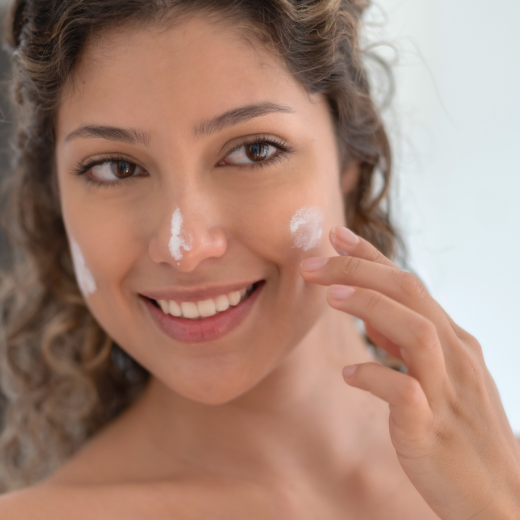How To Apply SPF The Right Way
Posted by Ellie Swain on Jul 22nd 2022
Most of us know that we need to wear sunscreen daily. After all, it helps protect against wrinkles, brown spots, and even skin cancer.
But, even the best of us can get confused about how much sunscreen to use, when to put it on, how often to reapply, and so on. That’s where we come in to help.
Wherever you are in the world, whether it be a sun-soaked, far-away island, or a sky-scraping city, it’s essential to wear a trustworthy SPF. Here’s our guide on how to stay protected all day long.
What’s the Right Amount of SPF to Use?
First thing’s first – the SPF of your sunscreen should be 15 or higher. If you’re spending a lot of time outdoors in the sun, it should ideally be higher than 15.
Ensure the sunscreen is labeled as ‘broad spectrum’, which means it protects against UVA and UVB rays. It would be best if you also looked for products that have earned The Skin Cancer Foundation’s Seal of Recommendation to ensure it's safe and effective.
How Should You Apply Sunscreen?
Have you heard of the two-finger rule? The two-finger step is the most common and often forgotten rule of thumb (sorry for the pun).
A drop or two of sunscreen won’t help your skin under the beating hot sun or even on an overcast day. Use two fingers to thoroughly rub in enough sunscreen to protect your skin.
While it may seem like a thick coating, it will guarantee to protect your skin to the max. Take your desired sunscreen on your index and middle finger and start massaging into your skin.
And remember that sunscreen must be reapplied every two hours. If you go for a dip (lucky you), towel off, or get sweaty with a workout, it should be applied even more often.
How Much Sunscreen Should You Use?
This leads us to exactly how much sunscreen you should use. Almost nobody uses as much sunscreen as they should.
To achieve the SPF listed on a bottle, you should use around two milligrams of sunscreen per square centimeter of skin. Of course, you may not know exactly what that looks like – think of it as like a shot glass full or around two tablespoons of sunscreen.
For just the face, apply a nickel-sized dollop. If you’re using a spray, use it until an even sheen appears on the skin.
Where Should You Apply Sunscreen?
Skin cancer can appear on any part of the body, even those not exposed to UV rays. But people often forget to apply sunscreen on the scalp, back of the neck, tips and back of the ears, around the eyes, and the tops of the hands and feet.
The best way to ensure complete coverage is to apply sunscreen all over the body before you get dressed. Then, reapply to all exposed skin later in the day.
While hair protects the scalp from the beating sun to some extent, you often need more protection than that, especially if your hair is thin. Around 10 to 15% of melanomas develop in the head and neck region , so it’s essential to take additional precautions by applying sunscreen or popping on your favorite hat.
Some products are designed especially for the part in your hair and the rest of your scalp, and these won’t leave residue or leave your hair greasy.
Lips – especially the lower lip - are particularly susceptible to skin cancer as they’re exposed to the sun daily and are one of the most common spots for basal and squamous cell carcinomas. Make sure to apply a lip balm or a sunscreen stick for the lips with SPF 15 or higher.
Some Great Sunscreens
There are, of course, plenty of sunscreens on the market, but here are a couple we’d love to recommend.
EltaMD UV Stick Broad Spectrum SPF 50
Are you seeking an excellent sunscreen you can take on the go? The EltaMDUV Stick Broad Spectrum SPF 50 is a perfect choice.
The handy UV stick is easy to apply, is mess and residue-free, and is dermatologist tested and designed for the whole family and all skin types. Use it at home or on the road to protect your skin from the sun’s rays.
This sunscreen is water-resistant and all-mineral with a high SPF of 50. It absorbs rapidly, blends easily, and doesn’t leave that unwanted white cast that many sunscreens tend to leave. Protect your skin against UVA (aging), UVB (burning), and HEV (blue light or high energy visible) rays with this versatile product.
Dermalogica Oil-Free Matte SPF 30
The DermalogicaOil-Free Matte SPF 30 sunscreen helps prevent premature aging and shine on oily, breakout-prone complexions. The formula is lightweight and ultra-sheer, packed with an advanced blend of zinc, caffeine, gluconate, niacinamide, biotin, and yeast extract.
If you experience oily skin, this is the sunscreen for you. Enjoy an all-day matte finish, preventing shine and sunburn without powdery residue.
Do you want more SPF advice? Here’s how to choose the perfect sunscreen .

